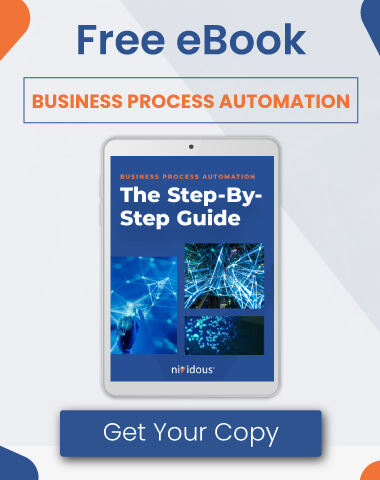Continuous improvement is a hot topic in business management circles, and for good reason: What manager wouldn’t want to ceaselessly upgrade operations? But the term can also be ambiguous, and there are multiple approaches—continuous improvement methodologies—that may all reach the same goal. You’ve probably heard of them: Total Quality Management, Lean Production, Kaizen, Six Sigma, and many more. Which methodology should your business implement?
Here’s an introduction to the subject, including coverage of some leading continuous improvement methodologies. This information will help you plan your own efforts toward process optimization.
Struggling to optimize core operations?
Learn how Nividous can help analyze, automate, and accelerate your business processes.
A Brief History Of Continuous Improvement
The modern concept of continuous improvement began around 1950, when Toyota’s Taiichi Ohno and Shigeo Shingo developed the Just-In-Time (JIT) manufacturing method (later, this movement would grow into Lean and Kanban methodologies). While continuous improvement continues to be associated with manufacturing, it has since been applied to business processes and services, too.
The tradition of continuous improvement has its roots in Walter Shewhart’s methods of statistical process control, developed in the 1920s. Shewhart’s Plan-Do-Check-Act (PDCA) cycle was an early continuous improvement methodology that was later folded into Lean and Kaizen theories. The PDCA cycle includes these four steps, designed to be carried out in a rotating cycle:
- Plan. Identify the desired change and make a plan to implement the improvement.
- Do. Run a small-scale pilot project or study to test the plan.
- Check. Collect data on the success (or lack thereof) of the change.
- Act. If the test showed promise, make the change at scale. If it didn’t, start over with another plan.
In the 1950s, American management theorist W. Edwards Deming introduced Shewhart’s ideas to Japanese executives. In the decades since, both PDCA and Deming’s focus on continuous quality improvement have been folded into multiple management theories, in Japan and beyond. Here’s a rundown of the leading continuous improvement methodologies within this intellectual lineage.
3 Top Continuous Improvement Methodologies and Tools
We asked business management consultants and executives which continuous improvement methodologies they prefer. Here are some of the top approaches they recommend.
1. Six Sigma
Six Sigma has been described as everything from a broad-reaching philosophy to a quality performance metric. Official accreditation is governed by a centralized organization, the Council for Six Sigma Certification, and awarded at various levels, up to Master Black Belt. But what is it, exactly?
At its core, the Six Sigma approach is a statistics-based methodology for continuous improvement. It gives business leaders a framework for realizing these improvements by removing defects in products and processes. In practice, Six Sigma includes five steps to improve a process, abbreviated DMAIC:
- Define. Identify a clear challenge or inefficiency. Establish clear goals and requirements for the project.
- Measure. Verify assumptions from the Define phase by collecting rigorous data on the process—and its results. Adjust goals and assumptions to match the reality reflected in the data.
- Analyze. Develop hypotheses about how a prospective change would affect the existing process. Use statistical analysis and testing to choose the hypotheses most likely to create the desired improvement.
- Improve. Implement the changes suggested by valid hypotheses—and continue to collect data on results throughout.
- Control. Scale the improvement across the organization. Establish standards for consistency. Gather results data and adjust as necessary.
This DMAIC cycle is for existing processes. For new efforts or products, Six Sigma suggests a similar model: Define, Measure, Analyze, Design, and Verify, or DMADV. This framework, along with the broader Six Sigma approach to quality improvement, helps users eliminate inefficiencies and errors—all with the standard goal of reaching fewer than 3.4 defects per million units, whether those units constitute products, processes, or tasks.
“The Six Sigma method is my personal favorite improvement methodology,” says Jenna Carson, a financial business partner at MoneyLucid.com. “The most important step is to ensure several staff members are trained in Six Sigma processes—and also data mining or data extraction.” That makes sense; like any good continuous improvement methodology, Six Sigma is rooted in data.
2. Theory of Constraints
Eliyahu M. Goldratt’s Theory of Constraints (ToC) is probably the only continuous improvement methodology to be introduced in the form of a novel. Goldratt and co-author Jeff Cox published The Goal in 1984; the novel describes an implementation of the Theory of Constraints in a manufacturing plant.
Rob Jolliffe, president of Sabre Limited and a Six Sigma-certified consultant, knows the novel (and the rest of Goldratt’s work) well and has taught courses on ToC. According to Jolliffe, this methodology helps to identify not just how to improve processes, but which processes to address.
“ToC is a philosophy and set of tools designed to help identify where the focus of improvement should be placed,” Jolliffe says. “Six Sigma (as an example, not to single it out) lacks a core philosophy of where to address change. That is, it does not specifically analyze the state of a system as a whole and identify where the best application of time and energy would be to make that system more effective. ToC presents the tools for this analysis.”
Goldratt’s system includes five phases for continual improvement, generally called the Five Focusing Steps:
- Identify a limiting factor, the titular “constraint.” For most companies, a constraint is anything that reduces income or limits productivity.
- Exploit the constraint. In other words, optimize use for whatever stands between you and your business goals. If a single machine can’t stamp out enough crucial parts, for instance, see if you can improve the machine’s output to reduce the impact of the constraint as much as possible.
- Subordinate other elements of your process to the limits of the constraint. This may seem counterintuitive, but when you overproduce on one task within a process, you introduce waste. Limit total process production to match the bottleneck.
- Elevate or expand the constraint. Once you have your whole system moving in lock step, you may find that the constraint you’re addressing really is slowing you down. Then it’s time to expand that constraint; buy more machines, hire more staff, invest more staff time, whatever it takes to remove the bottleneck.
- Repeat this process. Fixing one constraint often introduces another. The repetitive nature of this cycle is what makes it a continuous improvement methodology.
“The philosophy of ToC says that although individual areas can be improved to make a process locally better, if you don’t analyze the system holistically, you won’t necessarily make the entire business better,” Jolliffe says. “Improving a cog in the wheel of your system that doesn’t actually help turn the wheel faster won’t make a bottom-line difference.”
3. Total Quality Management
Remember W. Edwards Deming, the management consultant who played a heavy role in the development of Japanese continual improvement in the 1950s? Total Quality Management (TQM) traces its roots back to Deming’s work. The continuous improvement principles and methodologies associated with TQM are less regimented than Six Sigma, but the two approaches have similar aims. Toyota’s original Kanban and JIT processes for handling inventory and manufacturing are foundational examples of TQM in practice.
According to the American Society for Quality (ASQ), Total Quality Management breaks down into eight elements:
- Focus on the customer. Ultimately, customer satisfaction is the measure of quality.
- Broad-based strategy. Successful TQM takes a holistic and systematic approach to improving processes, products, and services.
- Connected systems. Every element of the business works together, without silos or isolated management tools.
- Focus on processes. In any business, isolated tasks make up broader processes; TQM requires managers to think in terms of end-to-end processes, not individual steps.
- Employee participation. Staff are empowered to self-manage, and all stakeholders pull together toward a common goal.
- Data-driven decision making. Accurate reporting and fact-based analysis are central to the theory of TQM.
- Effective communication between stakeholders. Lines of communication remain open, and all stakeholders share data promptly and through clear channels.
- Emphasis on continual process improvement. It’s axiomatic to say a continuous improvement methodology is concerned with improving continually, but in TQM, this approach is both a key element and the final goal of the strategy.
Jake Smith, owner of U.K. custom license plate supplier Absolute Reg, has used TQM to grow his business. “TQM redefines our managerial responsibilities, fixes potential loopholes, and focuses on achieving our goals,” Smith says. “Moreover, it enables us to measure work performance using relevant statistical tools that formulate real-time solutions to improve our work processes. Most importantly, it increases employee empowerment and involvement in essential matters that promote business growth.”
Even if you don’t rigorously adopt a single framework, there’s plenty to learn from all these continuous improvement methodologies as you work toward your own optimization goals.
Customizing Process Improvement Methodologies
At the top of this post, we asked which of these options is best for driving continuous improvement at your operation. The most compelling answer might be “none of the above,” says Amanda Russo, CEO of business operations consulting firm Cornerstone Paradigm. “True operations professionals know that you cannot fit a business problem into an academic exercise,” Russo says. “Most of those methodologies were developed 30 years ago and are no match for today’s complex problems.”
On the other hand, the answer could just as easily be “all of the above.” You’re free to pick and choose elements of each approach, and most managers draw on multiple theories to create a unique solution. Even if you don’t rigorously adopt a single framework, there’s plenty to learn from all these continuous improvement methodologies as you work toward your own optimization goals. For help with process analysis, Business Process Management, and, ultimately, end-to-end intelligent automation that drives continual improvement, contact Nividous today.





![Business Process Automation: Your Complete Guide [2023]](https://nividous.com/wp-content/uploads/2023/09/Business-Process-Automation-Your-Complete-Guide-2023-Blog-Feature.webp)